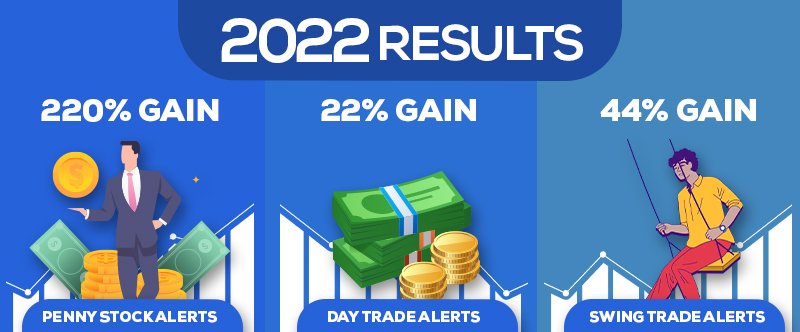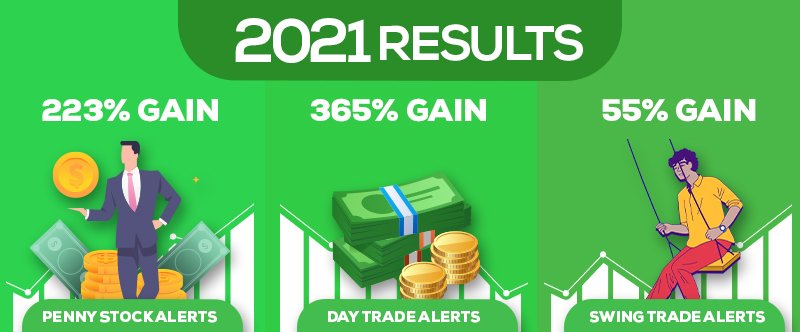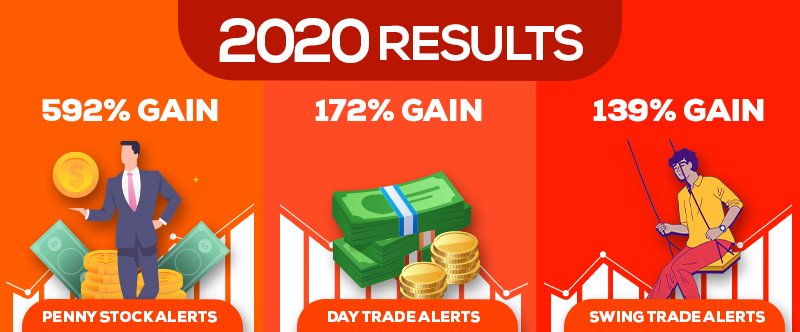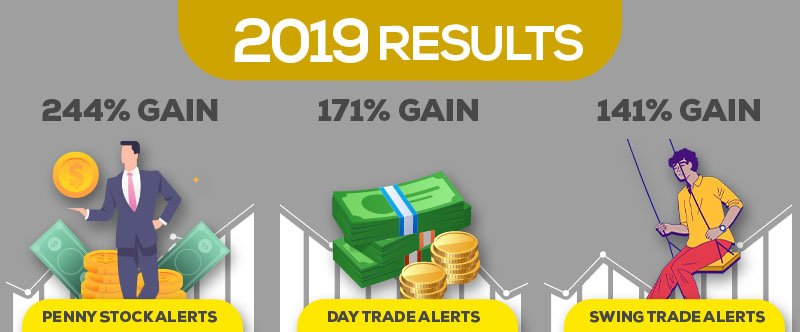Daily Stock Picks Results for 2019 - 2024
Exciting update! Our 2023 performance surpassed both 2021 and 2022. The monthly averages for both day trading and penny stocks exceeded 30%!
Anticipating even more significant gains next year, especially with our enhanced day trading strategy. In 2023, the overall monthly gains from all alerts combined reached an impressive 65%!
As you know 2022 has not been the best of years in the stock market! However, our alerts have still performed well so far this year with averaging over 18% with our penny stock alerts. Just like what was mentioned in 2021, it is best to use both the penny and day alerts together to maximize on the profits. 2022 ended up being one of the worst years in the stock market.
Our day trade alerts averaged the best gains with over 30% per month. Penny stocks averaged around 18% per month. If you would like to maximize your gains, best to use our day trading and penny stocks alerts together. Since they are traded at different times, the results can be combined together. Almost 50% gains per month for 2021 when combining penny and day trades together.
Our best performer for 2020 was our penny stocks which has averaged almost 50% per month! Our second best performer has been our day trading with over 14%. Our swing trades have not been that far behind with around 11% per month. Best to use all our alerts together because you will have more variety in your portfolio along with taking advantage of making profits not only during the active hours but also the after and premarket hours. Each day we are offering new stocks through both our penny stocks and day trading picks.
For the year 2019 – Our penny stock alerts have performed the best with averaging 20% per month. Our day trade alerts have averaged 14% per month. And our swing trade alerts, stilled average over 10% per month. If you would like to maximize your profits, the it is best to combine the day trades and penny stock alerts together. Everyday, we offer new daily stock picks. In you do wish to trade everyday, then you can once a month with our swing trades. We also offer a 7 day trial with all our monthly services. App for Daily Stock Picks.
March 2024 Results
Feburary 2024 Results
January 2024 Results
Use Discount Code trade25 to Get 25% Off All Subscriptions!
Penny Alerts
-
Daily Stock Picks
-
Buy & Sell Same Time
-
2022 Year - Over 200%
Swing & Penny Alerts
-
Daily & Monthly Stock Picks
-
Buy & Sell Same Time
-
2022 Year - Over 250% Combined
Day, Swing, Penny Alerts
-
Daily & Monthly Stock Picks
-
Buy & Sell Same Time
-
2022 Year - Over 280% Combined
-
Best Deal Per Month
Day, Swing, Penny Alerts
Yearly Membership-
Daily & Monthly Stock Picks
-
Buy & Sell Same Time
-
2022 Year - Over 280% Combined
-
Less than $16 per Month - $200 per Year with Discount Code!
No Hassle Unsubscribe
We believe our daily stock picks will be of great value to you. If you wish to discontinue using, no problem. You can unsubscribed at any time via Paypal by clicking HERE.
Top Stock Cart Results compared to S&P 500
Pick 3 Predications for Today
The S&P 500, a widely followed stock market index, serves as a barometer for the overall health of the U.S. equity market. As we reflect on the past five years, investors have witnessed a rollercoaster of economic events that have significantly influenced the performance of the S&P 500. This article delves into the key highlights and trends that shaped the index’s trajectory during this period.
Post-Recession Recovery (2019-2020):
The S&P 500 embarked on a robust recovery following the global financial crisis of 2008. By 2019, the index reached new record highs, fueled by strong economic fundamentals, low unemployment rates, and corporate profit growth. Investors were optimistic about the bull market’s continuation, but the emergence of the COVID-19 pandemic in early 2020 brought about a sudden and severe downturn.
The Pandemic Plunge (2020):
The onset of the COVID-19 pandemic led to unprecedented market volatility. In March 2020, the S&P 500 experienced a sharp decline, marking one of the quickest bear markets in history. Governments worldwide implemented lockdowns, causing disruptions to global supply chains and business operations. Central banks responded with aggressive monetary policies, and fiscal stimulus measures were introduced to stabilize economies.
Unprecedented Government Interventions:
The U.S. government’s response to the economic fallout of the pandemic played a pivotal role in shaping the S&P 500’s recovery. The Federal Reserve implemented interest rate cuts and launched extensive asset purchase programs to provide liquidity and support financial markets. Simultaneously, Congress passed several stimulus packages to assist businesses and individuals, contributing to a market rebound.
Technology Dominance and Work-from-Home Trend:
Amid the pandemic, technology stocks emerged as clear winners. Companies facilitating remote work, online communication, and e-commerce experienced substantial gains. Tech giants such as Apple, Amazon, Microsoft, and Alphabet played a significant role in driving the S&P 500 to new heights, highlighting the increasing importance of the technology sector in the modern economy.
Inflation Concerns and Interest Rate Dynamics (2021-2022):
As economies recovered and inflation concerns mounted, central banks signaled a shift in monetary policy. The anticipation of rising interest rates led to market fluctuations, impacting interest-rate-sensitive sectors such as technology and growth stocks. Investors closely monitored policy statements and economic indicators for insights into the potential future direction of interest rates.
Global Economic Factors and Trade Developments:
The S&P 500’s performance was also influenced by global economic factors and trade tensions. Trade negotiations between the U.S. and China, geopolitical events, and the global economic recovery played crucial roles in market sentiment. Uncertainties in these areas could lead to periods of market volatility.
Environmental, Social, and Governance (ESG) Investing:
Over the past few years, there has been a growing emphasis on ESG considerations in investing. Companies with strong environmental, social, and governance practices gained attention, and investors increasingly incorporated ESG criteria into their decision-making processes. This trend is expected to continue shaping the investment landscape.
Conclusion:
The past five years have been a testament to the resilience of the S&P 500, navigating through economic challenges and uncertainties. From the post-recession recovery to the unprecedented events of the COVID-19 pandemic, the index has demonstrated its ability to adapt to evolving market dynamics. As investors look to the future, staying informed about global economic trends, technological advancements, and policy developments will remain crucial in navigating the complex landscape of the S&P 500.




